Z690 vs B660 Motherboards: Battle of the Tech Giants
Imagine standing on the battlefield of performance computing, your weapon of choice – a motherboard, that tiny yet potent tech warrior that forms the bedrock of any computer system. The protagonists in this high-stakes duel are none other than the Z690 vs B660 motherboards. As you dive into the riveting world of these magnificent titans, you’ll quickly realize that selecting between them is not just about picking one over the other; it’s an intricate dance balancing power, performance, cost-effectiveness, and future-proofing.
The Z690 and B660 aren’t just random assortments of numbers and alphabets but represent Intel’s newest lineup in their motherboard series – unleashing unprecedented advancements set to redefine computing as we know it. So, gear up for an adrenaline-pumping journey through circuit lanes and silicon valleys as we compare these mighty contenders head-to-head! Whether you’re a seasoned techie or just getting warmed up to the intricacies of PC components, this showdown will leave you with great insights on making your next big tech decision.
Contents
- 1 Comparative Analysis: Z690 vs B660 Motherboard
- 2 Our Top Picks for Z690 Motherboards
- 3 Our Top Picks for B660 Motherboards
- 3.1 MSI MAG B660 Tomahawk WiFi DDR4 Gaming Motherboard
- 3.2 ASRock B660M MicroATX Motherboard
- 3.3 ASUS Prime B660-PLUS D4 LGA 1700 ATX Motherboard
- 3.4 GIGABYTE B660M DS3H DDR4 Motherboard
- 3.5 Major differences between Z690 vs B660 Motherboards
- 3.6 Practical Applications: Which One to Choose?
- 3.7 Final Thoughts
- 3.8 FAQs
- 3.9 Which motherboard is better for gaming, Z690 or B660?
- 3.10 Are there any cost differences between the two motherboards?
- 3.11 Do both these motherboards have the same socket type?
- 3.12 Which motherboard offers more connectivity options?
- 3.13 Are both Z690 and B660 compatible with 12th Gen Intel processors?
Comparative Analysis: Z690 vs B660 Motherboard
Diving into the components of a computer system, two primary contenders that take center stage are the Z690 vs B660 motherboards. In the sea of high-speed performance and computing efficiency, these duos, released by Intel to escort its Alder Lake CPUs, offer distinct features that may sway your purchasing decision. Venturing into comparisons, choosing between Z690 and B660 primarily boils down to deciding how much emphasis you place on overclocking capabilities and PCIe 5.0 support.
While they share certain similar specifications like support for DDR5/DDR4 memory & Intel 12th gen processors compatibility, there’s a stark contrast in terms of available features-set. The Z690 pulls ahead with full PCIe 5.0 support and CPU/memory overclocking, allowing enthusiasts more headroom to push their systems to the limit – perfect for power users who yearn for advanced-level configuration & maximum performance possible from their setup.
On the contrary, if you’re on a tighter budget or want enough juice for casual gaming or content creation without delving deeper into tweaking processing speeds – B660 is certainly a worthy contender: It offers a noteworthy balance of value for money while still packing considerable punch beneath its hood.
Our Top Picks for Z690 Motherboards
In our ongoing quest to equip modern technology enthusiasts with the best gear, we review premium products that significantly boost performance and add a sense of prestige to your PC build. The introduction of Z690 motherboards has brought majestic features like DDR5 RAM support, USB 3.2 Gen 2×2 ports, and long-awaited PCIe 5.0 lanes, which ensures lightning-fast data transfer. As tech enthusiasts ourselves, we’ve oiled our gears and conducted extensive tests to bring you this detailed rundown of top picks for Z690 Motherboards.
MSI PRO Z690-A WiFi ProSeries Motherboard
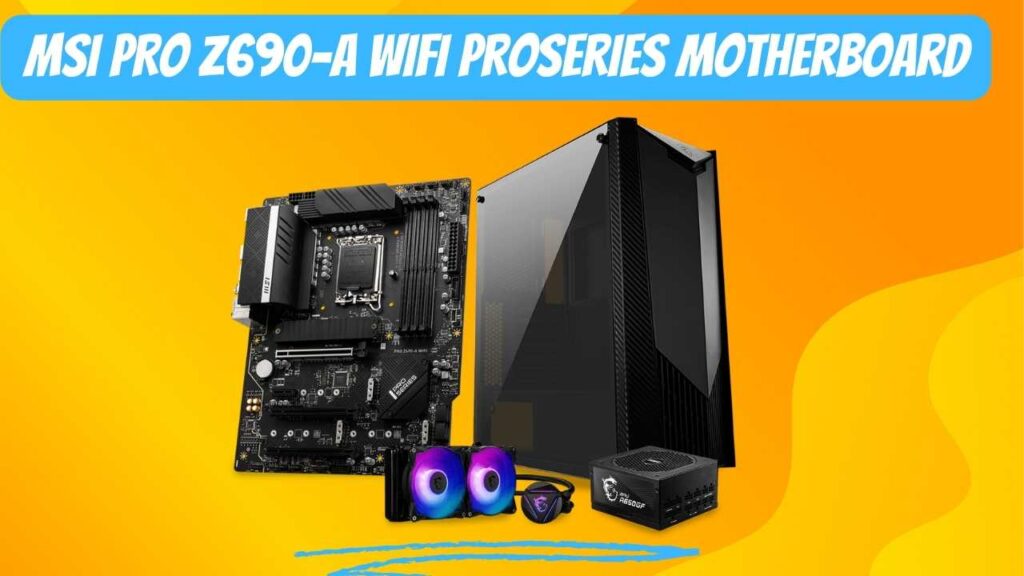
The MSI PRO Z690-A WiFi ProSeries motherboard is a game-changer. Not only does it exhibit the blend of cutting-edge technology features you’d expect from one of the best Z690 motherboards, but it also offers stability and reliability in spades. Catering to high-performance systems, this board reinvents your computing experience with its 12th Gen Intel Core Support and LGA 1700 Socket, enabling efficient and powerful operation seamlessly.
One key feature setting this majestic motherboard apart from competitors is the DDR5 memory support, offering lightning-speed data transfer, which is vital for tasks demanding broader bandwidth, such as hardcore gaming or intensive multitasking scenarios. The integration of PCIe 5 provides twice the speed of its predecessor, guaranteeing compatibility with future technologies. Additionally, it all sits atop an ATX form factor, ensuring all these technological wonders fit perfectly into your computer case, breathing new life into your computing system. Its multiple M.2 slots provide ample storage space for ultra-fast NVMe SSDs, ensuring quick boot-ups and instantaneous application launches.
The MSI PRO Z690-A WiFi ProSeries doesn’t compromise on connection either – its in-built WiFi 6E capabilities, along with a robust 2.5G LAN, mean you can connect faster than ever before regardless of whether you’re aiming to dominate online gaming matches or partaking in marathon zoom meetings. It’s not just ahead of the curve; it defines it! This marvel encapsulates power, connectivity and brilliant design like no other motherboard – MSI really has surpassed itself with this tech masterpiece.
Pros:
- Compatible with the most outstanding 12th Gen Intel Core processors.
- Standard ATX size for broad case compatibility.
- Supports DDR5 for enhanced system performance.
- Utilizes PCIe 5.0 for more instantaneous data transfer rates.
- Features 2.5 Gigabit LAN for high-speed wired networking.
- Welcomes M.2 slots for high-speed NVMe SSD storage.
- Sustains USB 3.2 Gen 2 for high-speed data transfer.
Cons:
- ATX size might be too large for users with space constraints.
- Higher-end motherboards may consume more power.
- Some features may be unnecessary for standard users.
GIGABYTE Z690 AORUS Elite AX DDR4
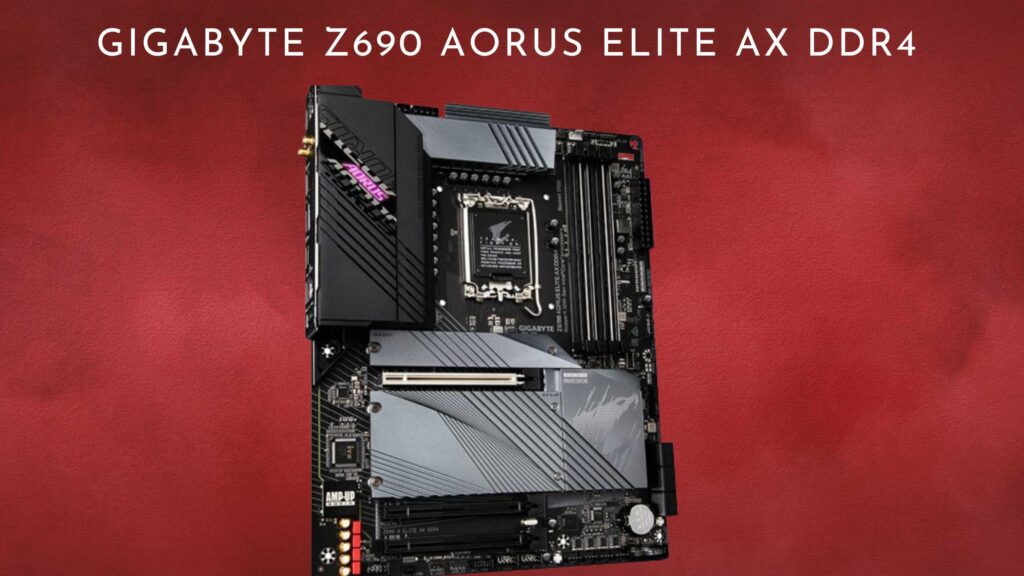
Unleash unparalleled performance and empower your gaming like never before with the all-new GIGABYTE Z690 AORUS Elite AX DDR4 motherboard. Specifically crafted to exceed the expectations of modern gamers, this revolutionary motherboard runs on Intel’s LGA 1700 chipset interface, delivering high-speed data transfer that shatters previous limits. Its DDR4 memory supports a wide range of frequencies for impressive speed and responsiveness, while its Quad M.2 PCIe sockets take onboard storage potentials to new heights.
The transformer among motherboards, the GIGABYTE Z690 AORUS Elite AX DDR4, boasts advanced connectivity options such as USB 3.2 Gen2X2 Type-C, aiding in quick data transfers and reducing waiting time significantly. Engineered with WiFi 6 technology and Gigabit Ethernet, it ensures blisteringly fast internet speeds for uninterrupted gaming sessions and crisp online interactions. With support for 2.5GbE LAN incorporated within its design—your overlocker dreams just got real! So why restrict yourself when you can transcend ordinary gaming experiences?
Pros:
- Ample storage expansion prospects for SSDs.
- High-speed wireless connectivity for gaming and streaming.
- Faster Ethernet speeds for improved network performance.
- Standard size for compatibility with various cases.
- Visually appealing aesthetics for a stylish build.
- User-friendly setup for system tweaking and customization.
- Optimizations for graphics, audio, and network performance.
Cons:
- Relatively expensive for budget-conscious users.
- Extensive features may overwhelm new PC builders.
- Compatibility issues may require a BIOS update, which is challenging for beginners.
ASUS Prime Z690-A LGA 1700 ATX Motherboard
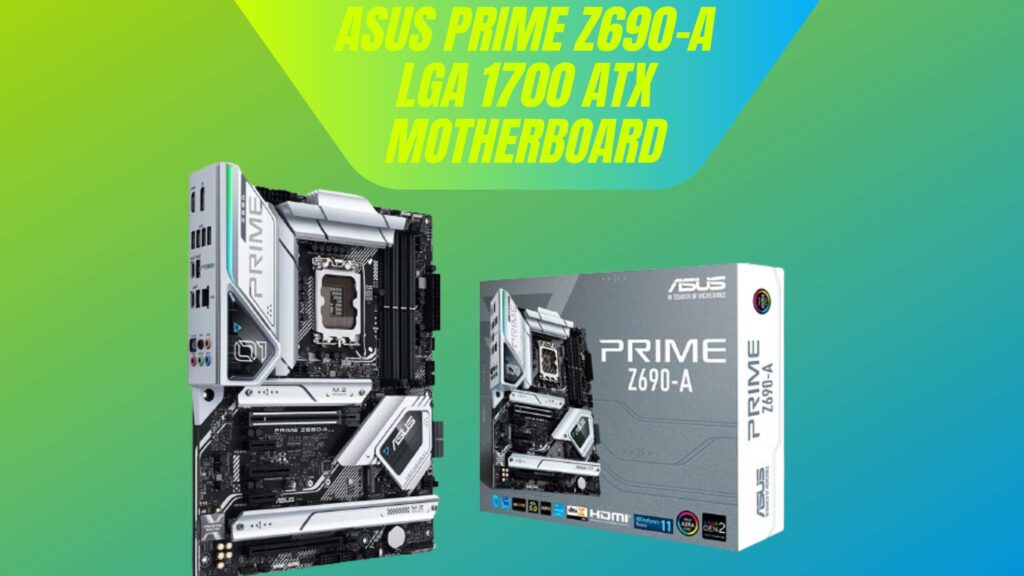
Delve into the world of unparalleled performance and blazing speed with the ASUS Prime Z690-A LGA 1700 Motherboard. This meticulously designed gem is one for the techie buffs, capable of supporting Intel’s 12th generation processors right out of the box. Loaded with unique features like 16+1 DrMOS for maximized power efficiency, a PCIe 5.0 interface for high-speed hardware communications, and DDR5 memory compatibility, this motherboard is literally paving the way to upgrade your rig to the next-generation dream machine.
The ASUS Prime Z690-A makes linking various devices a breeze! It features four M.2 slots, which provide unparalleled data storage and retrieval speed compared to rival products. The advanced 2.5 Gb LAN and USB 3.2 Gen2 Type-C ports from Intel allow for quicker connections than ever before, delivering exceptional versatility when it comes to connectivity options. Additionally, its Thunderbolt 4 support enhances your viewing experience, while the Aura Sync RGB Lighting customization lets you create an engaging atmosphere by syncing up with your preferences.
Pros:
- 16+1 DrMOS design for efficient power allotment and stability.
- Cutting-edge PCIe technology for high-speed data transfer.
- Future-proof memory support with improved bandwidth.
- Multiple slots for fast SSD storage expansion.
- Faster Ethernet speeds for improved network interpretation.
- Convenient and fast front panel connectivity.
- Customizable RGB lighting for an aesthetically pleasing build.
Cons:
- Limited options for devices fully utilizing PCIe 5.0 speeds.
- This may not fit well in compact cases, limiting build options.
- Beginners might find the extensive features challenging to navigate.
- Limited availability of Thunderbolt™ 4 peripherals.
ASUS ROG Strix Z690-E Gaming Motherboard
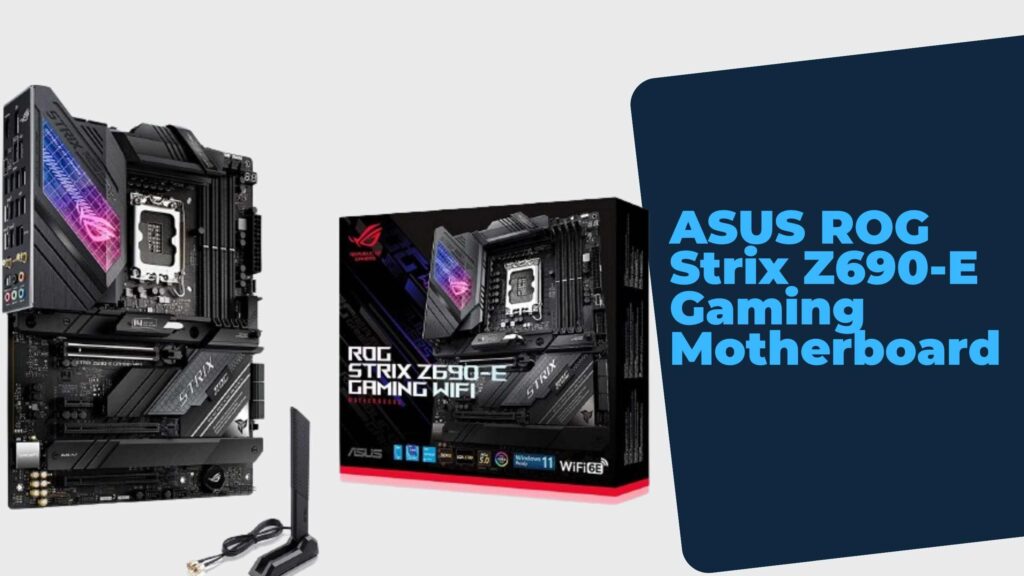
Unleash the beast of gaming power with the ASUS ROG Strix Z690-E Gaming WiFi 6E LGA1700 (Intel 12th Gen) ATX Gaming Motherboard! Packed to the brim with premium features catered for high-performance gaming, this is a motherboard that takes no prisoners. Masterminded for gamers with a penchant for ultimate performance, its PCIe 5.0 provides unmatched transmission speed, whereas DDR5 compatibility guarantees blazing-fast memory operations.
If network stability and ultra-fast internet connection pique your interest, the integrated WiFi 6E and 2.5 Gb LAN stand out as key assets of this stunning motherboard. Create immersive gaming experiences courtesy of Thunderbolt 4 support that allows lightning-speed data transfers and display connections. Load your games faster than ever before with not just one or two but five M.2 slots, along with an additional PCIe 5.0 M.2 slot and a unique ROG Hyper M.2 Card to fulfill those hearty storage demands without compromising speed.
The ASUS ROG Strix Z690-E isn’t all about internal prowess; it doesn’t forget your external peripherals, either! The front panel comes equipped with USB 3.2 Gen 2×2 Type-C ports, ensuring you can connect, charge, or transfer at unrivaled speeds with utter simplicity! This is indeed more than just a motherboard; it’s an unbeatable warship paving the way for uncharted territories in gaming dominance.
Pros:
- Future-proof with PCIe 5.0, DDR5, and Thunderbolt 4.
- Reliable wireless for lag-free gaming.
- 2.5 Gb LAN for lightning-fast wired connections.
- 5 M.2 slots and PCIe 5.0 M.2 support.
- ROG Hyper M.2 Card for top-tier data transfer.
- Front panel USB 3.2 Gen 2×2 Type-C for fast connectivity.
- Standard size fits various cases for versatile builds.
- Optimized for Intel’s latest processors.
Cons:
- Premium features mean a premium price.
- ATX size may not fit smaller builds.
- High-end features may increase power consumption.
- Extensive settings may overwhelm new users.
Our Top Picks for B660 Motherboards
For the passionate and devoted hardware enthusiasts out there, our team understands your insatiable hunger for the latest technology! That’s why we’re here to feed your curiosity regarding some of the industry’s most riveting developments. In this case, we review our top picks for B660 motherboards. With an ever-expanding market teeming with innovative gadgets and devices, it can indeed be a daunting task to zero in on what fits you best. After extensive testing and scrupulous comparisons based on performance, price, and overall experience – we’ve compiled a list designed just for you. We guarantee these products will change your perception of efficiency and redefine convenience!
MSI MAG B660 Tomahawk WiFi DDR4 Gaming Motherboard
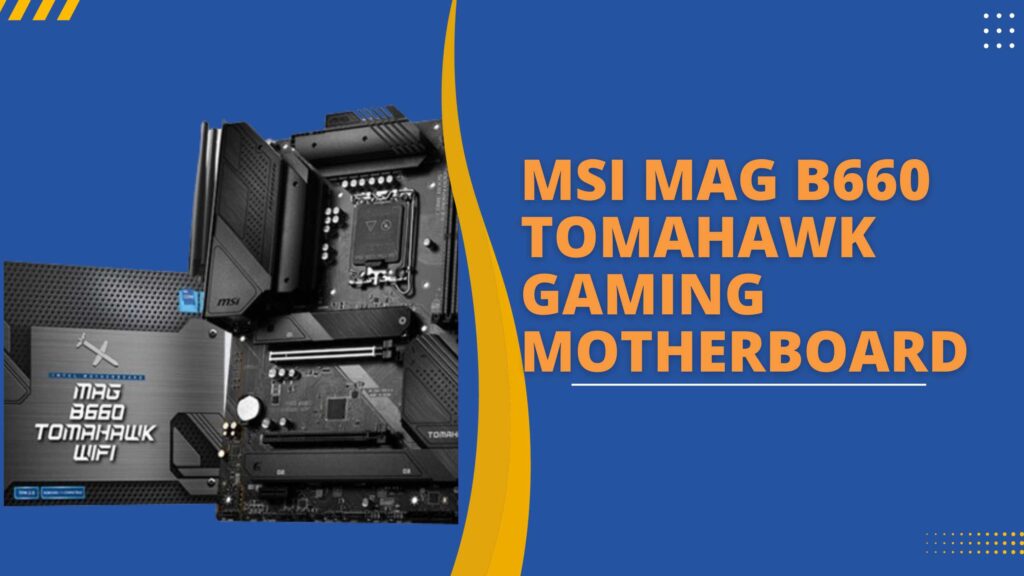
For gamers seeking uncompromised power and performance, the MSI MAG B660 Tomahawk WiFi DDR4 Gaming Motherboard reigns supreme. A splendid addition to the b660 motherboard family, it encapsulates groundbreaking features that ensure your system accelerates on every level imaginable. This exceptional ATX motherboard is designed specifically for 12th Gen Intel Core processors using an LGA 1700 socket- promising blisteringly fast and ultra-responsive gameplay like never before.
Bearing PCIe 4 functionality and 2.5G LAN support, this motherboard enables rapid data transfer speeds so you can revel in intensive gaming sessions without a hitch! It also comes equipped with M.2 Slots to facilitate unrivaled storage capabilities alongside lightning-fast access times. With onboard WiFi 6 technology, the online multiplayer experience reaches new heights of connectivity – ensuring that latency becomes a thing of past nightmares. The MSI MAG B660 Tomahawk WiFi DDR4 is more than just a gaming motherboard; it’s an unquestionable game-changer in the realm of b660 motherboards!
Pros:
- Excels with 12th Gen Intel Core and DDR4.
- Supports the latest peripherals and GPUs.
- Durable and stable for gaming.
- Multiple fan headers and heatsinks.
- 2.5G LAN, Wi-Fi 6 for lag-free gaming.
- Expand storage with NVMe SSDs.
- Easy overclocking and customization.
- High-quality for system longevity.
Cons:
- Requires larger PC case, limiting build flexibility.
- Fewer Type-C ports for peripherals.
- Crowded environments may affect wireless performance.
- It has effective cooling but generates more noise.
ASRock B660M MicroATX Motherboard
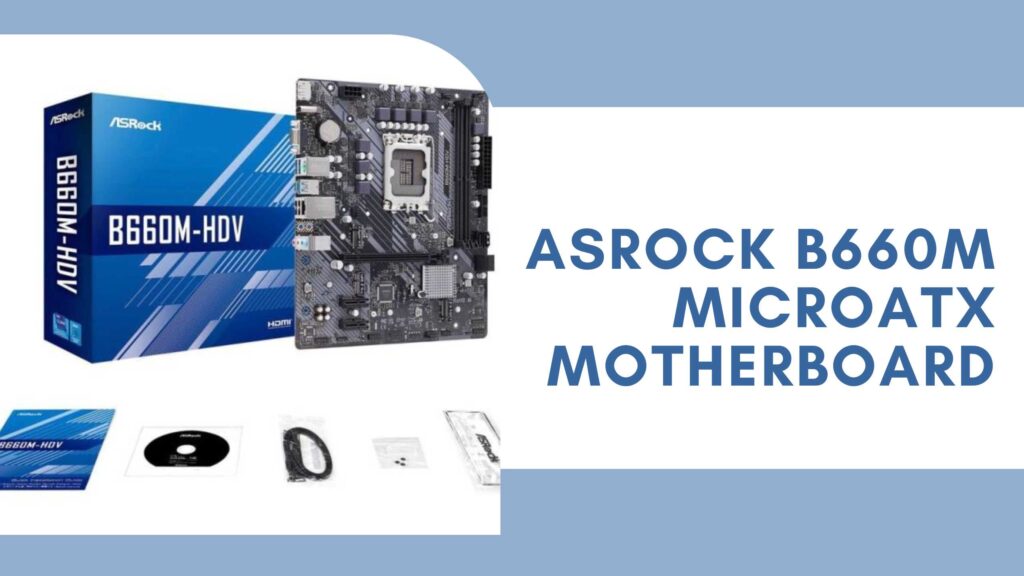
The ASRock B660M-HDV MicroATX Motherboard is an impressive addition to the B660 series and hosts a slew of features that place it as a cornerstone in the motherboard industry. It’s Intel LGA1700 CPU compatible, making it a strong contender when stacked against power players like Z690 motherboards. Laden with technological advancements such as 10 USB ports, including the coveted Type-C, HDMI port for smoother video quality, and superior sound capacitors that ensure crisp audio outputs, this beastly equipment is your all-in-one solution for supreme gaming or arduous computing tasks.
Embracing PCI-Express 4.0 technology, this motherboard broadens bandwidths and delivers higher data transfer rates than its predecessors or competitors could ever dream of. Amidst the slightly nebulous distinction between Z690 and B660 motherboards, one clear factor sets apart ASRock’s creation – wider accessibility to users given its affordability without compromising performance capabilities. With supportive software like A-Tuning and FAN-Tastic tuning included in this beastly package, to say you are future-proofing your gaming rig would be an understatement! Consequently, adapting the ASRock B660M MicroATX Motherboard into your system means embracing powerful computing seamlessly integrated with exceptional functionality.
Pros:
- Affordable for budget-conscious users.
- Supports LGA1700 CPUs efficiently.
- Space-saving for smaller PC cases.
- Adequate for moderate gaming needs.
- Offers reliable LAN for online activities.
- Supports NVMe SSDs for faster storage.
- User-friendly for basic customization.
- Provides satisfactory audio for most users.
Cons:
- It’s not ideal for high-end gaming demands.
- Lacks support for the latest peripherals.
- Fewer slots for additional components.
- The minimal design may not appeal to users seeking RGB.
ASUS Prime B660-PLUS D4 LGA 1700 ATX Motherboard
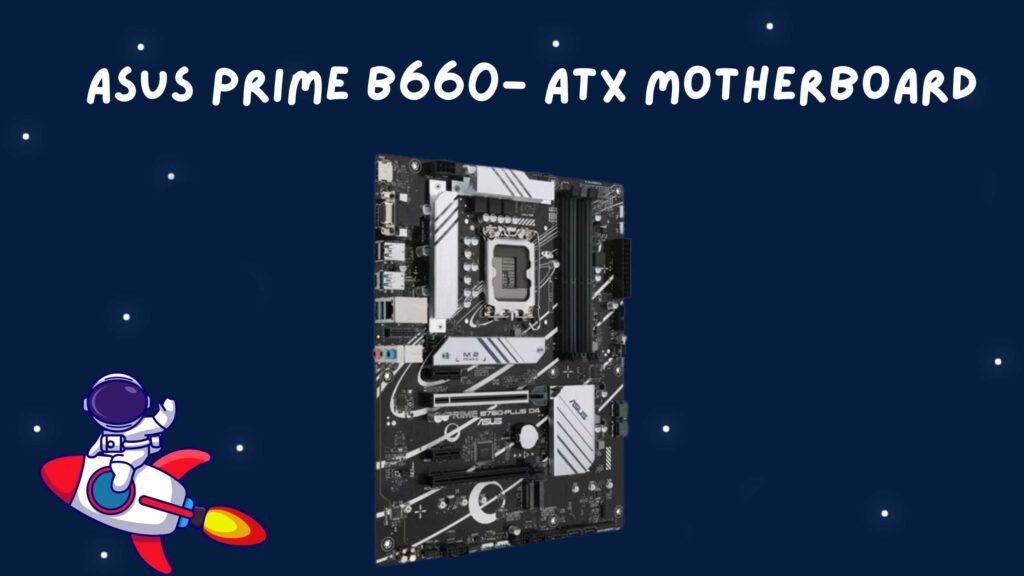
The ASUS Prime B660-PLUS D4 LGA 1700 ATX Motherboard is more than just a simple piece of your PC build. This advanced motherboard takes the intersection of design, compatibility, and capability to a whole new level. With stunning features like PCIe 4.0, DDR4, three M.2 slots, and 2.5Gb LAN support, it offers unprecedented flexibility for today’s tech-savvy users endeavoring towards the best performance in their every computing pursuit.
Yet what makes this motherboard genuinely stand out is its future-proof interface options – both on the front and back panels! The speedy USB, 3.2 Gen 2×2 Type-C at the rear, enables blisteringly fast data transfer speeds up to twenty times faster than traditional USB cables; indeed, a taste of tomorrow’s tech today! The Prime B660 even makes room upfront with a USB 3.2 Gen 1 Type-C designed for easy plug-in utility, while Thunderbolt™️4 header support ensures sleek interconnectivity with an array of peripherals. In essence, this board hands your versatility and robustness in one compelling package ready to serve as the cornerstone for next-generation systems!
Pros:
- Efficient compatibility with Intel 12th Gen CPUs.
- Suitable for larger PC builds with more expansion options.
- Harness the full potential of high-speed peripherals and GPUs.
- Versatile storage expansion with three M.2 slots.
- 2.5Gb LAN for swift and stable network performance.
- High-speed data transfer via the rear port.
- Convenient Type-C connectivity on the front panel.
- Future-ready with Thunderbolt 4 compatibility.
- Ample rear USB ports for various peripherals.
Cons:
- Minimal options for aesthetic customization.
- To utilize Thunderbolt, an additional device is needed fully.
- Effective cooling may generate more noise.
GIGABYTE B660M DS3H DDR4 Motherboard
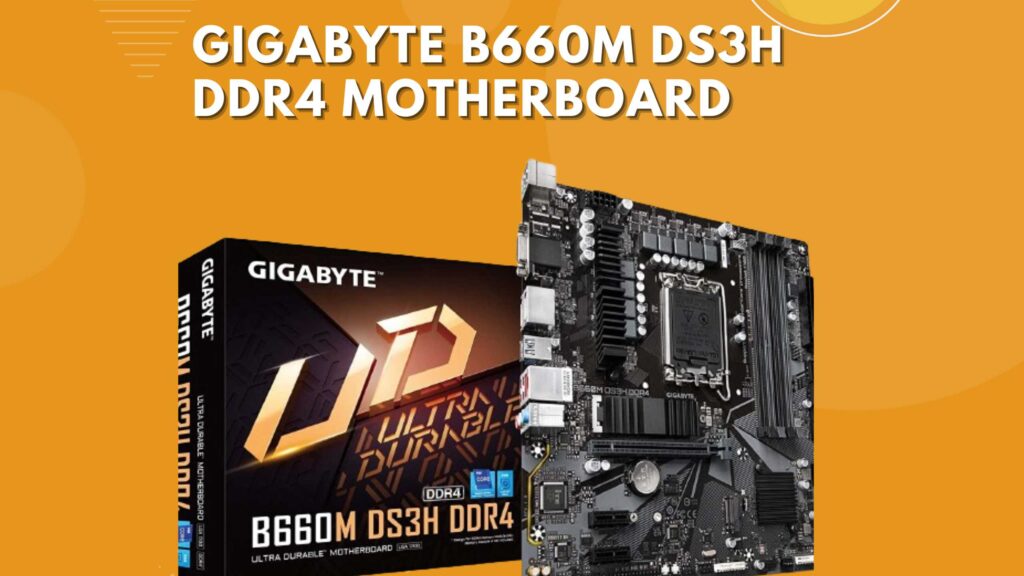
Unleash the potential of your computer with the GIGABYTE B660M DS3H DDR4 Motherboard, a technological marvel that promises exceptional performance. This advanced Micro-ATX motherboard is equipped with dual M.2 slots and PCIe 4.0, ensuring swift data transfer and enhanced multitasking abilities to satisfy even the most rigorous users. Its vigorous construction guarantees longevity, while its features are tailored to meet the needs of creators, gamers, and enthusiasts in pursuit of superior performance.
Complimented by its USB 3.2 Gen2 Type-C connectors, transferring heavy files will feel as swift as a light breeze, making your digital life smoother than ever before. It ups the ante further with its high-quality audio capacitors ensured to deliver crisp sounds perfect for immersive gaming experiences or music editing tasks; truly an all-around performer offering a seamless mix of speed and power on one board!
Speaking of power – the GIGABYTE B660M also has a 2.5GbE LAN connection, providing robust internet connectivity like no other – an absolute game-changer in times when stable online connections is paramount. Get ahead of the curve with the ambition of new technology packed into this small yet potent package – The GIGABYTE B660M DS3H DDR4 Motherboard! Experience next-level computing today.
Pros:
- Affordable for budget-conscious users.
- Efficient support for Intel LGA 1700 CPUs.
- Ideal for space-saving and smaller builds.
- Expand storage with support for two NVMe SSDs.
- Utilize high-speed peripherals and graphics cards.
- Reliable compatibility with DDR4 RAM.
- Provides a sufficient number of USB ports.
- Balances performance for casual gaming.
Cons:
- The minimal design may lack aesthetic appeal.
- Advanced users may find customization lacking.
- Lack of wireless connectivity may inconvenience some users.
- Audiophiles may find audio capabilities basic.
Major differences between Z690 vs B660 Motherboards
Diving into the heart of the matter, Z690 and B660 motherboards symbolize advancement in technology but serve divergent roles for different types of users. Unmasking their uniqueness, several pivotal attributes distinctly separate these two powerhouses – differences that could play a major role in your decision-making process. Here are the major differences between the two motherboard chipsets:
Overclocking Support:
The Z690 motherboards are designed for enthusiasts and users who want to push the performance limits of their system through overclocking. These motherboards typically feature robust power delivery systems, high-quality components, and advanced BIOS options. Overclocking allows users to increase the clock speeds of their CPU and memory beyond the manufacturer’s specifications, providing a potential boost in performance. Enthusiasts, gamers, and content creators who demand maximum computing power often opt for Z690 motherboards.
In contrast, B660 motherboards are more budget-friendly and generally offer limited overclocking capabilities compared to their Z690 counterparts. While they may still support some level of overclocking, the options and features are typically more basic. B660 motherboards are suitable for users who don’t prioritize extreme performance and are looking for a cost-effective solution.
PCI Express Lanes:
Typically, Z690 motherboards offer a larger quantity of PCIe lanes. These lanes play a vital role in linking several components like graphics cards, storage drives, and other peripherals. The extra PCIe lanes that Z690 boards come with facilitate numerous concurrent connections, which makes them an ideal choice for users in need of multiple rapid-speed devices.
B660 motherboards come with fewer PCIe lanes compared to their Z690 counterparts. While still providing ample connectivity for most users, the reduced number of lanes may limit the number of high-bandwidth devices that can be installed concurrently. This makes B660 motherboards more suitable for mainstream users with less demanding requirements in terms of PCIe connectivity.
Memory Support:
Motherboards of the Z690 variety are generally compatible with higher-speed RAM and frequently provide extra DIMM slots. This heightened RAM speed can boost the entire system’s performance, particularly for tasks that gain from increased memory bandwidth. Z690 boards’ extra DIMM slots provide a greater total memory capacity, which is ideal for those needing substantial RAM amounts for activities like video editing, 3D modeling, or virtualization.
B660 motherboards support slightly lower RAM speeds compared to Z690 boards. Additionally, they may have fewer DIMM slots, limiting the maximum amount of RAM that can be installed. While still providing sufficient memory support for most users, B660 motherboards are targeted at those who don’t require the highest possible memory performance and capacity.
Multi-GPU Support:
Z690 motherboards often come with support for multiple graphics card configurations, such as NVIDIA SLI or AMD CrossFire. This feature allows users to install and run two or more GPUs simultaneously, potentially boosting graphics enactment. This capability is particularly attractive to gamers and professionals in fields like content creation or 3D rendering, where the additional graphical horsepower can be beneficial.
In contrast, B660 motherboards generally lack support for multiple graphics card configurations. This limitation is a cost-saving measure and aligns with the target audience of mainstream users who are less likely to employ multiple GPUs. Most users, especially those focused on everyday computing tasks or gaming at moderate settings, find a single, powerful graphics card sufficient, making the absence of multi-GPU support on B660 boards less of a concern.
Price:
Due to their advanced features, robust build quality, and support for overclocking and multi-GPU setups, Z690 motherboards tend to be more expensive. Enthusiasts and power users who prioritize performance often find the additional cost justified for the enhanced capabilities and flexibility these motherboards offer.
B660 motherboards are positioned as more budget-friendly options. While they still provide a solid foundation for a variety of computing tasks, they are designed to meet the needs of mainstream users who may not require the advanced features found on Z690 motherboards. The cost-effectiveness of B660 motherboards makes them appealing to users who want reliable performance without breaking the bank.
Target Audience:
Z690 motherboards are geared towards enthusiasts, gamers, and professionals who demand high performance and advanced features. These users often engage in tasks that benefit from overclocking, multiple GPUs, and maximum system customization. Enthusiasts who build high-end gaming rigs or professionals working with resource-intensive applications are typical customers for Z690 motherboards.
B660 motherboards cater to mainstream users who prioritize affordability and solid performance for everyday computing tasks. These motherboards provide a stable platform for general use, moderate gaming, and productivity applications. Users who don’t require the extreme capabilities offered by Z690 motherboards but still want a reliable and cost-effective system often opt for B660 motherboards.
Practical Applications: Which One to Choose?
Diving into the intricacies of computing technology, it’s essential to highlight the critical role motherboards play in determining your computer’s overall capabilities. Let’s put the spotlight on two types of motherboards that have been dominating recent tech discussions – Z690 and B660. Here are some key points to consider for both Z690 and B660 motherboards:
Z690 Motherboards:
Overclocking:
If you are keen on maximizing the performance of your hardware through overclocking your CPUs and RAM, a Z690 motherboard would be an ideal option. These motherboards are generally engineered for power users and enthusiasts.
PCIe Lanes:
Z690 motherboards generally offer more PCIe lanes compared to B660. This means you have more bandwidth for accessory GPUs, high-speed storage, and other PCIe devices.
Memory Support:
Z690 boards often support faster RAM speeds, which can be beneficial for certain applications and gaming scenarios.
Multi-GPU Support:
Z690 motherboards are engineered to accommodate a multi-GPU setup, so they are suitable if you intend to drive several graphics cards simultaneously.
B660 Motherboards:
Budget-Friendly:
B660 motherboards are typically more budget-friendly than Z690 boards. If you’re building a system on a tighter budget, a B660 motherboard may allow you to allocate more funds to other components.
Limited Overclocking:
While some B660 motherboards may support mild overclocking, they are not as suitable for heavy overclocking as Z690 boards.
PCIe Lanes:
Compared to Z690, B660 motherboards possess a reduced number of PCIe lanes. If you require several high-bandwidth PCIe devices, this could be a factor to consider.
Mainstream Usage:
B660 motherboards are well-suited for mainstream users who do not require the advanced features and overclocking capabilities of Z690. They still provide good performance for gaming and general computing tasks.
Final Thoughts
Ultimately, the decision to opt for either the Z690 or B660 motherboards hinges on your unique needs and financial constraints. The Z690, with its advanced features such as PCIe 5.0 support and overclocking capabilities, is a superior option for those seeking high-end performance. Conversely, the B660 offers a cost-effective alternative without sacrificing essential features, making it ideal for those mindful of their budget or mainstream users. Both motherboards deliver outstanding performance within their respective markets. Therefore, whether you’re an avid gamer, a professional content creator, or an occasional user, it’s vital to thoroughly assess your needs before selecting one of these remarkable technological devices.
FAQs
Which motherboard is better for gaming, Z690 or B660?
While both can be used for gaming, the Z690, with its support for overclocking, may provide a slight performance edge over the B660.
Are there any cost differences between the two motherboards?
Yes, typically, Z690 motherboards are more expensive due to their advanced features, like a higher number of PCIe lanes and overclocking abilities.
Do both these motherboards have the same socket type?
Yes, both Z690 and B660 use LGA 1700 socket type compatible with Intel’s Alder Lake processors.
Which motherboard offers more connectivity options?
The Z690 generally offers more connectivity options, including USB Type-C onboard connectors and additional PCIe slots, compared to the B660.
Are both Z690 and B660 compatible with 12th Gen Intel processors?
Yes, both Z690 and B660 motherboards are designed to be compatible with 12th Gen Intel processors.